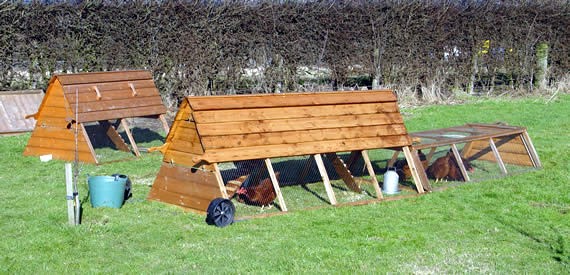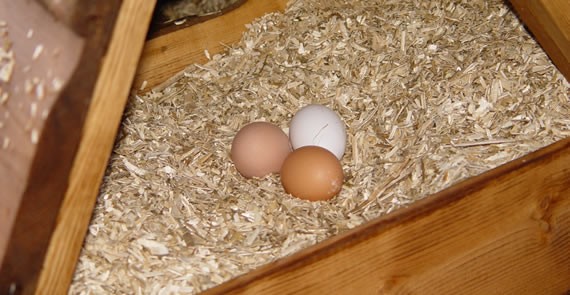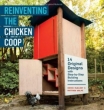Poultry Housing
Before you bring your hens home, you will need to have suitable accommodation for them. Even if they are going to have the run of your property, hens will need shelter from weather and predators.
There are many vendors of hen houses in the market and you will have your own criteria for selecting one. As with most things, cheapest is rarely the best quality; if you can actually SEE the product, it’s much easier to check quality of materials and build.
Build your own poultry house
If you are handy, then you can build your own, either from scratch or by adapting an existing building or shed. Michael Roberts’ book “Poultry House Construction”, published by Gold Cockerel books, is useful in this regard.
Buying second-hand
Be careful of buying second hand henhouses. Wood, especially if it is rotten or split, is a perfect harbour for red mite and other parasites, so take care when selecting materials or buying second-hand.
If you do buy second-hand, it might be wise to scorch the interior with a blowlamp to kill any mites on the wood surface or to treat it with creosote or creosote substitute before you move the hens in. A good dousing in a disinfectant like Virkon-S is also probably a good idea.
Roofing
Roofing felt should be avoided in henhouses as it can harbour red mite. Onduline, or similar, is useful as the corrugated shape also helps with ventilation. Use a bird-friendly paint e.g. Cuprinol on the wood. Creosote, or substitute, is useful in that it kills mites and other insects but it must be allowed to dry completely before the hens are put into the house.
Sizing poultry housing
As a general guide, you need about 25 - 30cm of perch space per hen, for roosting. The perch should be made of close-grained wood, so that it cannot easily harbour mites, and be about 5cm wide with the corners rounded off, so that the hen can perch in comfort. Don’t use round perches, for obvious reasons.
 Our first ark accommodated six hens, as our flock grew we invested in a larger ark
Our first ark accommodated six hens, as our flock grew we invested in a larger ark
Ideally, the perch should be no more than 45cm off the ground to avoid damage to the feet when the hen jumps down. If the house has multiple rows of perches, the highest should be at the back. Cleaning the house is made much easier if the perches are removable or can be folded out of the way.
Although hens naturally perch, they don’t necessarily know WHERE you want them to perch, so if you move hens to new accommodation or introduce new hens, check for the first few nights that they have a) found the house and that b) they have found the perches. You may need to lift them on to the perches for a few nights until they get the hang of it. Hens have “locking” mechanism in their legs so that when the leg is bent, the toes automatically clench, so they can perch while asleep.
Nest boxes
You will need a nest box for every four to five hens. These should be about 30cm x 30cm and easily accessible by you from outside the hen house, to make egg collection easier. It is not essential to line the nest box with any bedding, but it does make it easier to clean out and protects the eggs, as well as mimicking the hens’ natural behaviour. Use straw in preference to hay; hens can be prone to respiratory disorders and hay can be dusty or carry spores that can trigger problems.
We have a homemade, freestanding nest box. We found that two nest boxes in the Forsham weren't enough for twelve hens and there was either a queue, three hens squashed in one nest box and broken eggs or eggs being laid around the garden. The nest box works well and the hens seem to like it.
Our late cockerel, Hobbes, didn't seem to be able to work it, though. When he got in, he couldn't get out and had to be released - thankfully, we didn't keep him for his brains!
Shavings or other bedding can also be used. Always check the nest boxes when you let the hens out in the morning; if a hen has roosted in a nest box, she may well have defecated in it and this will lead to dirty eggs, so check and clean out the box first thing and every time you visit the henhouse.
 Most purpose-built poultry arks will have integrated nest boxes
Most purpose-built poultry arks will have integrated nest boxes
Freestanding plastic nest boxes are now available and are easy to clean. Roll-away nest boxes, too, are available – these have a sloping floor so that the egg rolls out of the nest box when it is laid, so that it doesn’t get dirty, broken or eaten.
Ventilation
Airflow in hen houses is important – good ventilation helps to prevent disease but hens don’t like draughts, so ensure that there are openings for air to flow above the roosting area.
In February 2002, in anticipation of getting our first hens, we purchased a Forsham Cottage Ark (model Boughton 902A) plus extension run. It's not the cheapest but it's beautifully built and we do have to look at it every day.
There are lots of other suppliers though. We liked the Boughton ark for a number of reasons.
Its attributes, in no particular order are; it looks good; it's well built; it seems to be well designed in relation to hens' natural behaviour; it offers some protection to the feed and grit hoppers that we have attached to the inside of the end panel, under the floor; with wheels, it's pretty easily moveable by one person, once you get the "wheel flick" technique right.
Bedding
The area under the perches should have a covering of some kind of bedding, partly for insulation but mainly to make it easier to clean out. Poultry manure makes a valuable contribution to the compost heap and acts as an activator, so when you clean out the henhouse, put the manure in your compost bins or a separate muckheap.
There are a number of bedding options – straw, shavings, shredded paper, but never hay for the reasons given previously.
We use hemp. Hemp is grown for the paper industry - the soft core of the plant is 'waste' and is made into animal bedding. It is very absorbent, dust extracted and rots down in the compost heap in 6-8 weeks. Shavings are fine but take an age to breakdown in the compost bins.
Don’t overdo the bedding – only a thin layer is required to ease mucking out. The faeces forms a layer on top of the bedding; if you put in 6 inches of bedding, you’ll throw most of it out pretty much unsoiled.

About Rosemary Champion
Rosemary lives on a 12 acre smallholding in Angus, in the east of Scotland, where she keeps Ryeland Sheep, Shetland cattle and assorted poultry. She was destined to be a smallholder from an early age.
Further Reading
 Chicken & Eggs: River Cottage Handbook No.11 Mark Diacono |  Storey's Guide to Raising Chickens Gail Damerow |  A Beginners Guide to Caring for Ex-Batts Jo Barlow |  Reinventing the Chicken Coop Matthew Wolpe |  Chickens: The Essential Guide to Choosing and Keeping Happy, Healthy Hens Suzie Baldwin |
Smallholding shop
When you click links below and make a purchase, this may result in this site earning a commission from eBay.

Brinsea Eco Glow 20 Brooder
The EcoGlow 20 chick… from £44.03 + p&p

Red Hale chick Feeder
Red plastic chick… from £6.26 + p&p

Hentastic Foraging Cake Feeder
Especially designed… from £2.13 + p&p

28-160 Rutland S/Poultry Net-Double Spike 50m
Super Poultry NettingKeep… from £129.30 + p&p
















